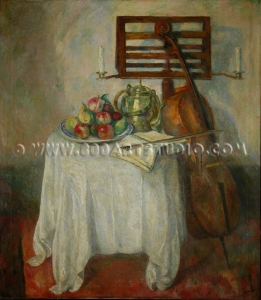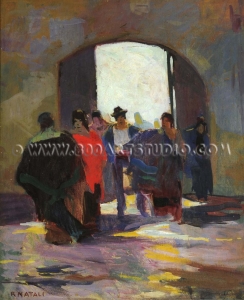 The term “post-Macchiaioli” has come to be used for all Tuscan painters active from the 1880’s to around 1920. These are artists who, for the most part, were disciples of their more famous predecessors: students from Giovanni Fattori’s School for Drawing Nudes in Florence and apprentices of Silvestro Lega, mentored in the house of Tommasi at Bellariva. They were Tuscan painters, bound to their own region, which they considered to be an inexhaustible source of inspiration and study; many chose the Maremma as their special territory, others their city of origin, and still others the region of the Torre del Lago and the Versilian coast.
The term “post-Macchiaioli” has come to be used for all Tuscan painters active from the 1880’s to around 1920. These are artists who, for the most part, were disciples of their more famous predecessors: students from Giovanni Fattori’s School for Drawing Nudes in Florence and apprentices of Silvestro Lega, mentored in the house of Tommasi at Bellariva. They were Tuscan painters, bound to their own region, which they considered to be an inexhaustible source of inspiration and study; many chose the Maremma as their special territory, others their city of origin, and still others the region of the Torre del Lago and the Versilian coast.
We are concerned here with Ulvi Liegi, Francesco and Luigi Gioli, Adolfo, Angiolo and Ludovico Tommasi, Giorgio Kienerk, Plinio Nomellini, Raffaello Gambogi, Benvenuto Benvenuti, Silvio Bicchi, Guglielmo Micheli, Leonetto Cappiello, Alfredo Müller, Vittorio Corcos, Angelo Torchi, Francesco Fanelli, Ferruccio Pagni, Guglielmo Amedeo Lori, Mario Puccini, Lorenzo Viani, Oscar Ghiglia, Llewelyn Lloyd, Gustavo Sforni, Giovanni Bartolena, Antonio Antony De Witt, Cesare Ciani, and others.
 Along with these artists, we also want to draw attention to the “Labronici”, a group of painters active between the beginning and middle of the twentieth century: Mario Cocchi, Cafiero Filippelli and Giovanni Marzo, and also Renato Natali and Gino Romiti, to name only a few. But also: Adriano Baracchini-Caputi, Eugenio Caprini, Giulio Cesare Vinzio, Eugenio Carraresi, Ettore Castaldi, Carlo Domenici, Giulio Ghelarducci, Paulo Ghiglia, Beppe Guzzi, Lando Landozzi, Giovanni Lomi, Manlio Martinelli, Gino Mazzanti, Mario Menichetti, Corrado Michelozzi, Gastone Razzaguta, Renuccio Renucci, Ferruccio Rontini, Luigi Servolini, Giovanni Zannacchini.
Along with these artists, we also want to draw attention to the “Labronici”, a group of painters active between the beginning and middle of the twentieth century: Mario Cocchi, Cafiero Filippelli and Giovanni Marzo, and also Renato Natali and Gino Romiti, to name only a few. But also: Adriano Baracchini-Caputi, Eugenio Caprini, Giulio Cesare Vinzio, Eugenio Carraresi, Ettore Castaldi, Carlo Domenici, Giulio Ghelarducci, Paulo Ghiglia, Beppe Guzzi, Lando Landozzi, Giovanni Lomi, Manlio Martinelli, Gino Mazzanti, Mario Menichetti, Corrado Michelozzi, Gastone Razzaguta, Renuccio Renucci, Ferruccio Rontini, Luigi Servolini, Giovanni Zannacchini.
The term “labronico” comes from Latin; it is used to indicate the stretch of the Tyrrhenian coast that runs from Livorno to Castigioncello. Indeed, most of these painters came from Livorno, and the city was a continuing source of inspiration for many of them. But others found inspiration for their work in the region immediately along the coastal strip. In the first twenty years of the new century – more precisely, in 1908, the year Giovanni Fattori died – this group made the Caffè Bardi in Livorno into a gathering place much like the Caffè Michelangelo had been for the Macchiaioli in Florence, that is, a fundamental spot to rediscover and reconfirm their work. The Labronici Group continues even to this day in Livorno and is part of the contemporary artistic reality of the city.
Written by : Cecilia Iacopetti – Translated by: Paola Ludovici and Nanette Cooper
© Studio d’Arte dell’800

